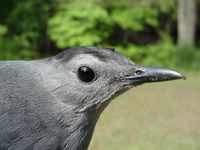|
|
|||
|
THIS WEEK at HILTON POND |
|
At this time of year, telephone calls often come in to Hilton Pond Center from folks who see "unusual" spring birds in their yards. One of the most common inquiries is about a little blue bird that starts showing up in the Piedmont by mid-April and even puts in appearances at sunflower seed feeders. 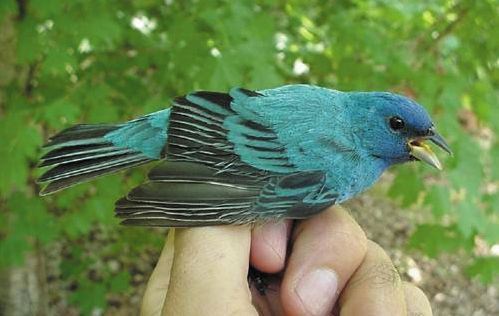 Many folks who are familiar with orange-breasted Eastern Bluebirds (below left) call to say they are bewildered by the sight of an exotic, sparrow-sized bird that is bright blue all over. Even from that brief description, however, there's never much doubt that the bird in question is a male Indigo Bunting, Passerina cyanea (above).
Up close, a male Indigo Bunting reveals a mix of several shades of blue--none of which, to our eye, resemble what we think of as "indigo"--but all of which are breathtaking nonetheless.
We haven't yet seen any female buntings in the spring of 2002, but this week we did catch a male in one of our mist nets. Amazingly, one hour later in precisely the same net section we caught a noticeably bigger bird that superficially resembled an Indigo Bunting on steroids. Although it had blue plumage and a two-tone beak similar to that of the bunting, the new bird also sported a large rusty shoulder patch--the definitive field mark for a Blue Grosbeak (above). Blue Grosbeaks, Guiraca caerulea, are more southerly in their breeding distribution than Indigo Buntings--seldom going further north than the Mason-Dixon Line--and they also can be found all the way to California. (The two species have similar winter ranges.) As with the Indigo Bunting, the male grosbeak is brightly colored while the female is dull brown. One easy way to differentiate bewtween Indigo Buntings and Blue Grosbeaks is by the size of the bill of the latter, which--as its name suggests--is quite large.
About the only additional "blue birds" we could have hoped for were a Barn Swallow and the increasingly elusive Cerulean Warbler, which breeds in the North Carolina mountains. We've never banded either of these two species--or even seen a Cerulean--but we're satisfied to have had up-close views this week of four different blue birds. Although we had the "blues" at Hilton Pond Center, it was the right kind, and we were far from despondent. 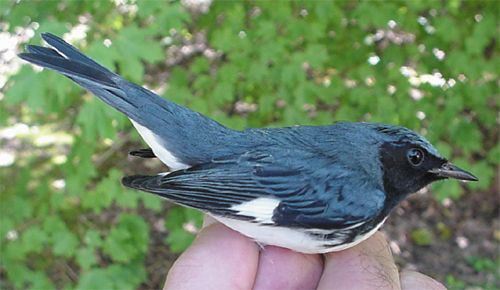 If you enjoy "This Week at Hilton Pond," please help Support Hilton Pond Center for Piedmont Natural History. It's painless, and YOU can make a difference! You may wish to consult our Index of all nature topics covered since February 2000. |

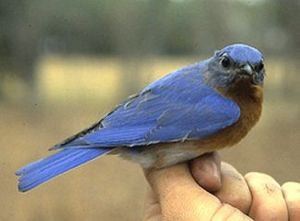 Indigo Buntings are Neotropical migrants--birds that spend our winter in Central or South America and return to North America each spring to breed. The Indigo Bunting overwinters in the West Indies and in Mexico south to Panama, with a few individuals lingering in south Florida and along the Texas Gulf Coast. They breed in the eastern half of the U.S. and southern Canada--including the Carolina Piedmont.
Indigo Buntings are Neotropical migrants--birds that spend our winter in Central or South America and return to North America each spring to breed. The Indigo Bunting overwinters in the West Indies and in Mexico south to Panama, with a few individuals lingering in south Florida and along the Texas Gulf Coast. They breed in the eastern half of the U.S. and southern Canada--including the Carolina Piedmont.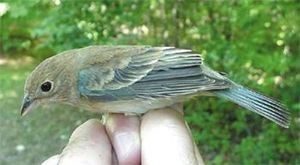 By contrast, the pale brown female may be the most nondescript bird in North America, with no field marks save the two-tone bill--black above and gray below--to even suggest that she is an Indigo Bunting. (Older females especially may have a hint of blue on the shoulder and at the base of the tail.) Her drab coloration is an adaptation that allows her to sit undetected on her nest. The brightly colored male typically sings from a highly visible perch at the top of the tallest tree in an open meadow; the female quietly incubates on a loosely woven nest that may be only a foot or two off the ground in low vegetation at the base of the male's singing tree.
By contrast, the pale brown female may be the most nondescript bird in North America, with no field marks save the two-tone bill--black above and gray below--to even suggest that she is an Indigo Bunting. (Older females especially may have a hint of blue on the shoulder and at the base of the tail.) Her drab coloration is an adaptation that allows her to sit undetected on her nest. The brightly colored male typically sings from a highly visible perch at the top of the tallest tree in an open meadow; the female quietly incubates on a loosely woven nest that may be only a foot or two off the ground in low vegetation at the base of the male's singing tree.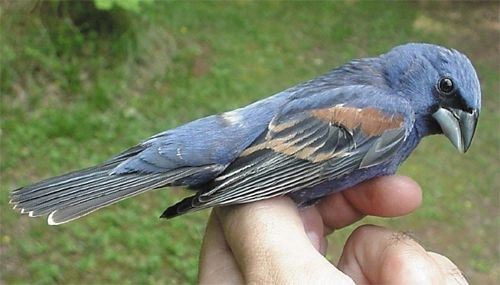
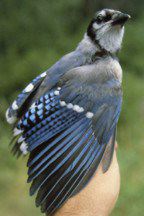 With all this blue flying through the neighborhood, we could hardly stop at just catching a male Indigo Bunting and a male Blue Grosbeak. In fact, we also caught and banded a male Eastern Bluebird AND the other two "blue birds" that might reasonably be expected at the Center in spring: a Blue Jay (left), and a male Black-throated Blue Warbler (bottom photo).
With all this blue flying through the neighborhood, we could hardly stop at just catching a male Indigo Bunting and a male Blue Grosbeak. In fact, we also caught and banded a male Eastern Bluebird AND the other two "blue birds" that might reasonably be expected at the Center in spring: a Blue Jay (left), and a male Black-throated Blue Warbler (bottom photo).